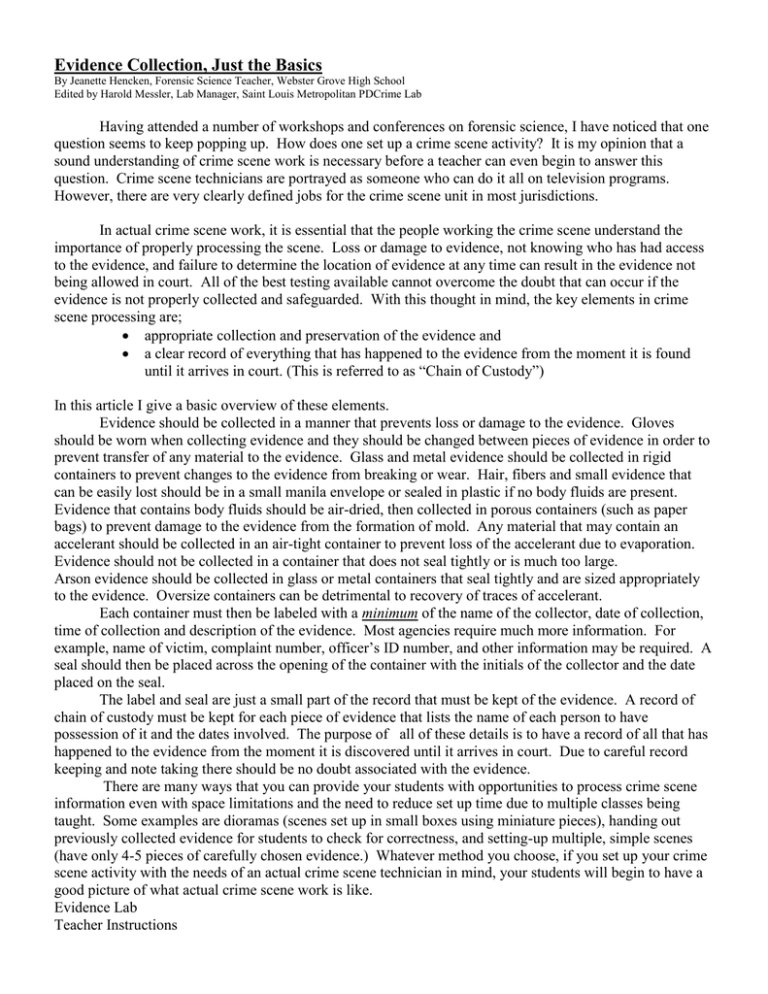Evidence Collection Lab Activity
advertisement

Evidence Collection, Just the Basics By Jeanette Hencken, Forensic Science Teacher, Webster Grove High School Edited by Harold Messler, Lab Manager, Saint Louis Metropolitan PDCrime Lab Having attended a number of workshops and conferences on forensic science, I have noticed that one question seems to keep popping up. How does one set up a crime scene activity? It is my opinion that a sound understanding of crime scene work is necessary before a teacher can even begin to answer this question. Crime scene technicians are portrayed as someone who can do it all on television programs. However, there are very clearly defined jobs for the crime scene unit in most jurisdictions. In actual crime scene work, it is essential that the people working the crime scene understand the importance of properly processing the scene. Loss or damage to evidence, not knowing who has had access to the evidence, and failure to determine the location of evidence at any time can result in the evidence not being allowed in court. All of the best testing available cannot overcome the doubt that can occur if the evidence is not properly collected and safeguarded. With this thought in mind, the key elements in crime scene processing are; appropriate collection and preservation of the evidence and a clear record of everything that has happened to the evidence from the moment it is found until it arrives in court. (This is referred to as “Chain of Custody”) In this article I give a basic overview of these elements. Evidence should be collected in a manner that prevents loss or damage to the evidence. Gloves should be worn when collecting evidence and they should be changed between pieces of evidence in order to prevent transfer of any material to the evidence. Glass and metal evidence should be collected in rigid containers to prevent changes to the evidence from breaking or wear. Hair, fibers and small evidence that can be easily lost should be in a small manila envelope or sealed in plastic if no body fluids are present. Evidence that contains body fluids should be air-dried, then collected in porous containers (such as paper bags) to prevent damage to the evidence from the formation of mold. Any material that may contain an accelerant should be collected in an air-tight container to prevent loss of the accelerant due to evaporation. Evidence should not be collected in a container that does not seal tightly or is much too large. Arson evidence should be collected in glass or metal containers that seal tightly and are sized appropriately to the evidence. Oversize containers can be detrimental to recovery of traces of accelerant. Each container must then be labeled with a minimum of the name of the collector, date of collection, time of collection and description of the evidence. Most agencies require much more information. For example, name of victim, complaint number, officer’s ID number, and other information may be required. A seal should then be placed across the opening of the container with the initials of the collector and the date placed on the seal. The label and seal are just a small part of the record that must be kept of the evidence. A record of chain of custody must be kept for each piece of evidence that lists the name of each person to have possession of it and the dates involved. The purpose of all of these details is to have a record of all that has happened to the evidence from the moment it is discovered until it arrives in court. Due to careful record keeping and note taking there should be no doubt associated with the evidence. There are many ways that you can provide your students with opportunities to process crime scene information even with space limitations and the need to reduce set up time due to multiple classes being taught. Some examples are dioramas (scenes set up in small boxes using miniature pieces), handing out previously collected evidence for students to check for correctness, and setting-up multiple, simple scenes (have only 4-5 pieces of carefully chosen evidence.) Whatever method you choose, if you set up your crime scene activity with the needs of an actual crime scene technician in mind, your students will begin to have a good picture of what actual crime scene work is like. Evidence Lab Teacher Instructions Purpose: To have the students determine if the evidence they are given was collected in an appropriate container, as well as, labeled and sealed correctly. Procedure: 1. For each pair of students, have two different types of evidence in containers. 2. The first piece of evidence should have “blood” on it. This could be a q-tip or some other item with stage blood or red paint on it. 3. The second piece of evidence can be either a piece of fiber, glass or a piece of metal. 4. Each group should have one piece of evidence that is in an appropriate container and one that is not. For the blood evidence, an appropriate container would be anything that is porous – a paper lunch bag or small manila envelope. An inappropriate container that is often chosen by the students is a plastic bag. The fiber evidence should be collected in a container that will prevent loss – a manila envelope (regular mailing envelopes have holes in the corners that make them a poor choice for trace evidence) or a zip-closure container are good choices. Any metal or glass evidence should be collected in a rigid container to prevent the evidence from being scratched or broken. 5. The evidence that is in an appropriate container should be incorrectly labeled or sealed. A label is information that is placed on the outside of the container, but not on the seal. At minimum, a correct label should contain the name of the person who collected the evidence, date and time collected and a description of the evidence. Some law enforcement officers would argue that it is too time consuming to put time on every piece of evidence. But anyone who has done crime scene work for an extensive period of time would tell you that it is important to include. The seal should be placed across the opening of the container and should contain the initials of the collector and the date collected. 6. Explain to the students that they should not open the containers and should assume that what is described on the outside is indeed what is in the container. 7. Each piece of evidence should be numbered with a permanent marker and the number recorded in a key. Your key should contain the number of the evidence, type of evidence, type of container, what is on the label and the seal. Name ___________________________________________________ Date _________________________ Evidence Lab Record the number of your evidence. ______________ 1. Are any parts of the label missing appropriate information? If yes, what information? 2. Is the evidence sealed properly? If no, what is missing? 3. Is the evidence packaged correctly? Is it in an appropriate container? Why or why not? Record the number of your evidence. ______________ 1. Are any parts of the label missing appropriate information? If yes, what information? 2. Is the evidence sealed properly? If no, what is missing? 3. Is the evidence packaged correctly? Is it in an appropriate container? Why or why not? Record the number of your evidence. ______________ 1. Are any parts of the label missing appropriate information? If yes, what information? 2. Is the evidence sealed properly? If no, what is missing? 3. Is the evidence packaged correctly? Is it in an appropriate container? Why or why not?

